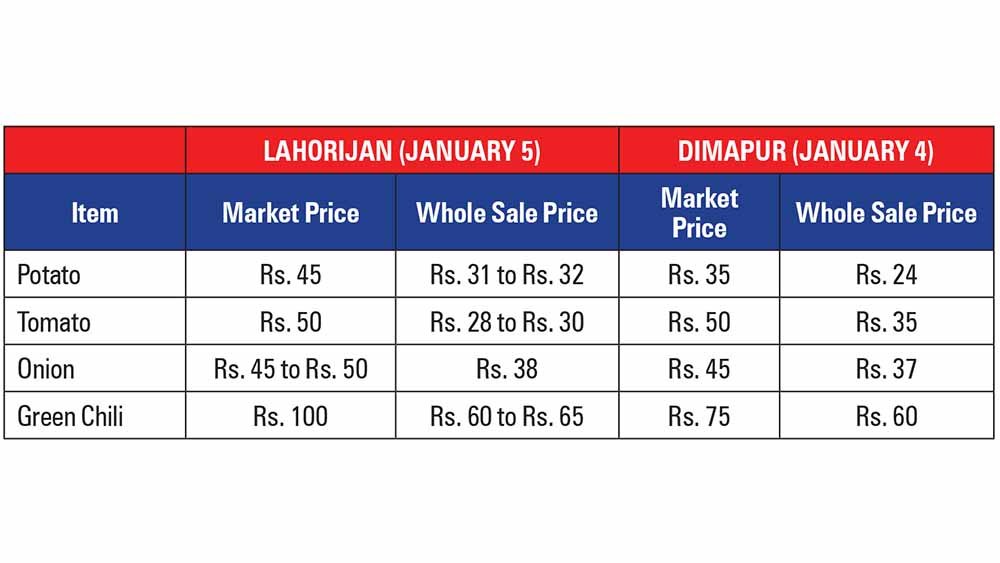As prices of various commodities in Dimapur experienced gradual rise to the point where the escalations defied commercial logic, directly proportionate to the number of ‘tax’ or ‘fee’ collections; the nearby markets at Lahorijan and Khatkhati in Karbi Anglong(Assam) grew steadily.
Dimapur market ruled the roost when many buyers even from Jorhat, Golaghat and Diphu used to shop till the mid-90s. However, extra heavy burden of tax and fee collections imposed at check gates and by syndicates at Dimapur, had huge added problem for traders who had to pass the burden to the customers.
This led many from Dimapur to shop at Lahorijan and Khatkhati especially during Sunday and when bandhs made their presence at Dimapur. Till a few years back, prices of vegetable and live and cut meat items at Lahorijan were almost half the prices in comparison with rates at Dimapur.
However, as more and more buyers from Dimapur went to Lahorijan and Khatkhati especially during Sundays, things began to change. First, the prices shot up at Lahorijan and became at par with Dimapur.
Traders and Lahorijan and Khatkhati functioned on the basis of day-to-day assessment and so prices became volatile. Currently, vegetable prices between Dimapur and Lahorijan, Assam, has revealed that the prices at Dimapur are becoming less costly in comparison. This is because the market at Dimapur is vast and also regulated while it is not so at Lahorijan and Khatkhati.
Thus, Dimapur market appears to offer more affordable options that is slowly going against the popular concept that prices at Lahorijan markets are cheaper. This is yet to register in the minds of a majority of a few thousand Sunday shoppers from Dimapur who have made Lahorijan and Khatkhati a must for shopping vegetables, poultry and pork.
A visit to the Lahorijan market by this reporter on Sunday revealed significantly higher prices for daily use essential commodities compared to Dimapur’s rates set by the Dimapur Municipal Council (DMC) on January 4.
For instance, the market price of potatoes in Lahorijan stood at Rs. 45 per kg, while DMC price was set Rs. 35 per kg. Similarly, tomatoes were priced at Rs. 50 per kg in both markets, even though wholesale rate in Dimapur was Rs. 5 to Rs.7 more expensive than in Lahorijan, which was at Rs. 28 to Rs. 30 per kg.
Onions were also marginally cheaper in Dimapur, with a market price of Rs. 45 per kg, compared to Lahorijan’s Rs. 45 to Rs. 50 per kg, and wholesale rates at Rs. 37 and Rs. 38 per kg, respectively.
Green chilies (Tepa) showed the starkest difference, being sold at Rs 100 per kg in Lahorijan while DMC set its price at Rs. 75 per kg, a difference of Rs. 25 per kilo. (See table below)
A street vendor in Lahorijan openly admitted to inflating prices by Rs. 5 to Rs. 10 on Sundays, taking advantage of the high demand from Dimapur shoppers who are regular and big buyers on Sundays.
As per the rates set by the DMC and the price in Lahorijan, even on weekdays Dimapur offers comparable or cheaper rates, raising questions about the rationale behind the shopping preference.
Despite this, shoppers from Nagaland continue to cross the state border to buy vegetables, citing cheaper price and freshness as their reasons. Reflecting this mindset, a woman from Dimapur, shopping at the Lahorijan market reiterated that prices were cheaper in Lahorijan than in Dimapur.
When this reporter informed her of the rates fixed by the DMC that were actually cheaper in Dimapur, she admitted that she was not aware of the prices in Dimapur, nor the price set by DMC but continued to shop without restraint.
Another lady too claimed that prices at Lahorijan were cheaper. When this reporter informed her of the rates fixed by DMC, she alleged that the vendors at Dimapur did not follow the DMC rates.
Asked whether she had complained with the civic authorities on the mobile number provided at the rate chart of the DMC, she replied in negative. The lady went on that it should be the duty of DMC to regularly check the prices, and not the other way around.

